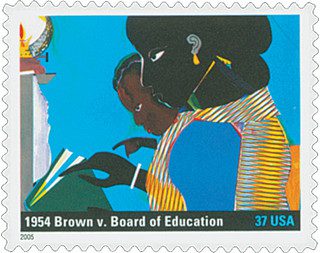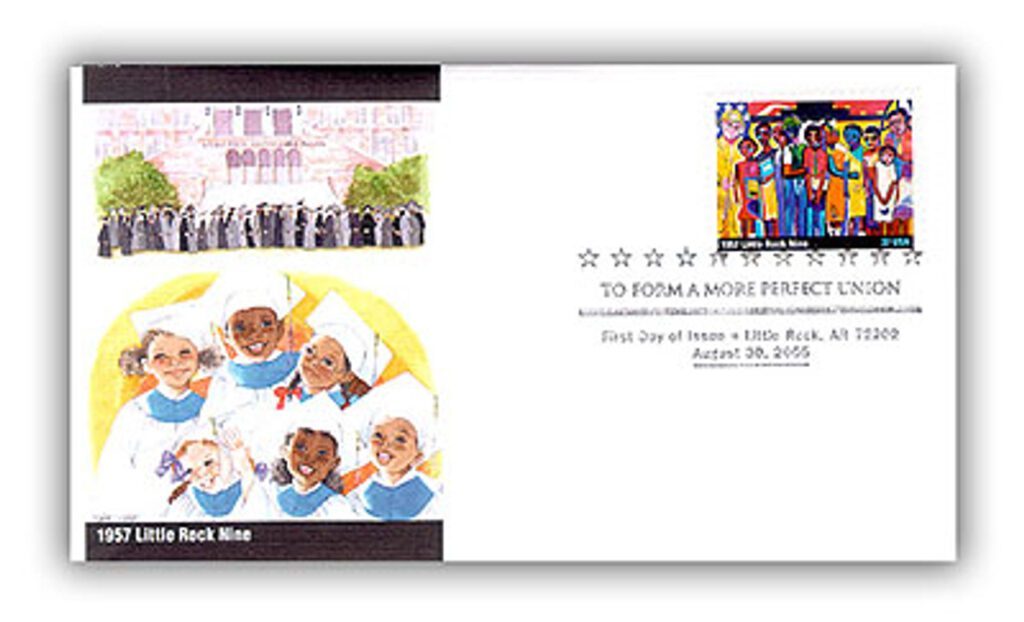
After being initially denied entrance to their school, the Little Rock Nine were escorted in by federal troops on September 25, 1957 — a turning point in the Civil Rights Movement and a dramatic test of federal authority over states.
The struggle for school desegregation had begun three years earlier. On May 17, 1954, the US Supreme Court handed down its unanimous decision in Brown v. Board of Education of Topeka, declaring that “separate educational facilities are inherently unequal.” This landmark ruling struck down decades of legal segregation under the Plessy v. Ferguson precedent and declared that state laws establishing separate schools for Black and white children were unconstitutional under the Equal Protection Clause of the 14th Amendment. For civil rights advocates, it was a monumental victory that promised to dismantle one of the pillars of institutionalized racism in America. But in many parts of the South, including Little Rock, Arkansas, resistance to integration was fierce and immediate.

When the 1957–58 school year approached, Little Rock’s school board announced that Central High School — one of the most prestigious schools in the state — would begin the process of integration. Roughly 75 African American students applied to transfer to the previously all-white school. After careful screening, only nine were selected for their academic strength and resilience. These students would become known as the Little Rock Nine: Melba Pattillo, Minnijean Brown, Ernest Green, Elizabeth Eckford, Gloria Ray, Jefferson Thomas, Carlotta Walls, Terrence Roberts, and Thelma Mothershed.
But not everyone welcomed this step toward equality. Governor Orval Faubus openly opposed integration and, in a highly publicized move, called out the Arkansas National Guard to surround Central High and prevent the Black students from entering. Faubus justified his actions by claiming that violence would erupt if the students tried to attend, famously warning that “blood would run in the streets.” This confrontation set the stage for one of the most dramatic showdowns of the civil rights era.
On September 4, 1957, Elizabeth Eckford arrived alone at the school — unaware that plans had changed to have the students arrive together — and faced a screaming mob. Television cameras and newspapers captured the jeers, racial slurs, and threats shouted at the young girl as she stoically walked toward the school, only to be turned away by the Guard. These images shocked the nation and drew international attention.

After federal courts ordered Faubus to stop using the Guard to block the students, the Little Rock Nine made another attempt to attend school on September 23. This time, they made it through the doors, but they were met with hostility inside the building. White students spit on them, tripped them, and shouted insults. Outside, the mob became more aggressive and threatened to storm the school. Fearing for the students’ lives, school officials removed them through a side door.
President Dwight D. Eisenhower, seeing the crisis escalate into a direct challenge to federal authority, acted decisively. He federalized the Arkansas National Guard and dispatched 1,200 troops of the US Army’s 101st Airborne Division to Little Rock. On September 25, under the protection of soldiers with bayonets fixed, the Little Rock Nine entered Central High School together and began what would be a grueling school year. The 101st patrolled outside the school and escorted the students through the hallways. In November, a task force of Arkansas guardsmen took over the duty, continuing to protect them until the end of the year.
Eight of the nine students persevered and completed the historic year, enduring relentless harassment but proving that desegregation could succeed under federal protection. Ernest Green became the first Black graduate of Central High School in May 1958, marking another symbolic victory.

Throughout this ordeal, the students had the steadfast support of Daisy Bates, president of the Arkansas NAACP. Bates offered her home as a safe meeting place and headquarters, even as she faced constant threats. Rocks were thrown through her windows, accompanied by menacing notes that read, “Stone this time. Dynamite next.” Despite the danger, Bates continued to encourage the students and advocate for their right to an equal education.
The Little Rock Crisis became a defining moment in the civil rights struggle. It demonstrated the federal government’s willingness to intervene when states defied court orders, and it inspired other communities to continue the fight for equality.
| FREE printable This Day in History album pages Download a PDF of today’s article. Get a binder or other supplies to create your This Day in History album. |
Discover what else happened on This Day in History.


All of the First Day in History articles are very interesting, and educational.
This brings stamp collecting to a higher level of enjoyment.
Substantive and informative, that’s what “stamp collecting” has become with this extra dimension. Agreed 100%. I wait for every article to learn and enjoy the wealth of information behind every stamp in “This Day in History”. “Commendable” does not do enough justice to these articles. Keep up the Good Work, Mystic Stamp Company!!!
Great victory !!!!!!!!
A shameful time in America’s history
I was attending Clemson College this day in history, starting my Sophomore semester in September 1957. Interesting times with much more to come. I was attending the University of Georgia when it was integrated. Graduated in 1962.
I was nine years old at the time and living in Washington, DC. I remember it very well. Hopefully, we are somewhat better now.
I wish racist people and groups would stop this hate. We need to work together and save our country so our children can have a wonderful,hate free nation to live and love together.
We can if God is brought back into the daily lives of all. Evil will always try to upset Good.
As usual this article was informative. I was lucky enough to be able to get tickets to the 50th Anniversity Celebration in 2007, and enjoyed it very much. My only confusion with the article is How did the NAACP stop the Guard from blocking the students?
Kudos to the eight children who were able to finish the school year, to President Eisenhower and to Daisy Bates. Even with the roadblocks and unresonable thinking this is still a great country. We must always remember that and we will surely endure.
Sequoia National Park–125 years ago,on September 25, 1890, Congress created America’s second national park, protecting the largest groves of giant sequoia trees from logging interests. Sequoias are the largest and among the oldest living things on the planet, and they grow only on the western slopes of the Sierra Nevada in California.. A few days later, more sequoia groves were protected to the north when Yosemite National Park was established.